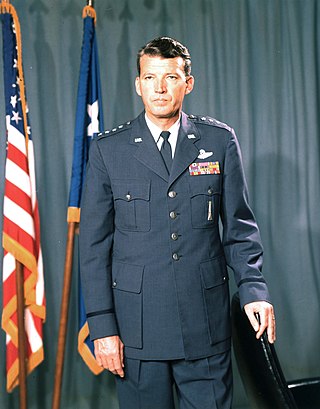The United States Armed Forces are the military forces of the United States. The armed forces consist of six service branches: the Army, Marine Corps, Navy, Air Force, Space Force, and Coast Guard. All six armed services are among the eight uniformed services of the United States.

Buckley Space Force Base is a United States Space Force base in Aurora, Colorado named after United States Army Air Service First Lieutenant John Harold Buckley. The base is run by Space Base Delta 2, with major units including the U.S. Space Force's Space Delta 4, the Colorado Air National Guard's 140th Wing, the Denver Naval Operations Support Center, and the National Reconnaissance Office's Aerospace Data Facility-Colorado.

New Boston Space Force Station (BOSS) is a United States Space Force facility located in Hillsborough County in south central New Hampshire. It was transferred from the United States Air Force to the Space Force in the summer of 2020.

The 50th Wing is an inactive United States Air Force wing.

The 22d Space Operations Squadron is a satellite control unit of the United States Space Force. It is part of Space Delta 6 and is located at Schriever Space Force Base, Colorado. Prior to July 2020 it was part of the 50th Network Operations Group, itself a part of the 50th Space Wing.

The 2nd Space Operations Squadron is a United States Space Force unit responsible for operating the Global Positioning System (GPS) satellite constellation, which provides global navigation, time transfer, and nuclear detonation detection. It is a component of Space Operations Command's Positioning, Navigation, and Timing Integrated Mission Delta (Provisional) and headquartered at Schriever Space Force Base, Colorado.

The 21st Space Operations Squadron is a satellite control unit of the Space Delta 6 of the United States Space Force, located at Vandenberg Space Force Base, California. Prior to July 2020, it was part of the 50th Network Operations Group. It operated Onizuka Air Force Station from its formation in 1991 until the closure of the station in 2010.

The 3rd Space Operations Squadron is a United States Space Force unit responsible for conducting on-orbit operations. It is located at Schriever Space Force Base, Colorado.

The United States Space Force's 4th Space Operations Squadron is a satellite operations unit located at Schriever Space Force Base, Colorado. 4 SOPS is part of Space Delta 8 and responsible for command and control of the Milstar/Advanced Extremely High Frequency, Defense Satellite Communications System Phase III, and Wideband Global SATCOM satellite constellations. The 4th Space Operations Squadron's mission is to operate the Space Force's protected and wideband MILSATCOM systems. They provide warfighters global, secure, survivable, strategic and tactical communication during peacetime and throughout the full spectrum of conflict. The squadron also operates three mobile constellation control stations at various locations in conjunction with host partners. At higher readiness levels and during exercises, these personnel deploy with U.S. Strategic Command and U.S. Northern Command respectively.

The 1st Space Operations Squadron is a United States Space Force unit responsible for space-based space domain awareness. Located at Schriever Space Force Base, Colorado, the squadron operates the Space Based Space Surveillance system, the Advanced Technology Risk Reduction system, the Operationally Responsive Space-5 satellite, and the Geosynchronous Space Situational Awareness Program.

The 23rd Space Operations Squadron is a satellite control unit of the United States Space Force. It is part of Space Delta 6 and is located at New Boston Space Force Station, New Hampshire. Prior to July 2020, part of the 50th Network Operations Group, itself a part of the 50th Space Wing.

The United States Space Force (USSF) is the space service branch of the U.S. Armed Forces. Along with the U.S. Air Force, it is part of the Department of the Air Force, led by the secretary of the Air Force. Its military heads are the chief of space operations, who is one of the Joint Chiefs of Staff, and vice chief of space operations.

Space Delta 2 is the United States Space Force's space domain awareness and space battle management delta and is headquartered at Peterson Space Force Base, Colorado. Space Delta 2 tracks and monitors all human made objects from low Earth orbit to geosynchronous orbit and further out to deep space. It also partners with the National Oceanic and Atmospheric Administration to provide weather satellite observation for the U.S. Armed Forces. It consists of the 15th Space Surveillance, 18th Space Defense Squadron, 19th Space Defense Squadron, and 20th Space Surveillance Squadron.

The United States Space Force is organized by different units: the Space Staff, the field commands, and the space deltas.

Space Delta 8 is the United States Space Force unit responsible for military satellite communications and operates a variety of satellite constellation. It is headquartered at Schriever Space Force Base, Colorado.

Space Delta 6 is a United States Space Force unit which assures access to space through the $6.8 billion Satellite Control Network and defensive cyberspace capabilities for space mission systems.

While the United States Space Force gained its independence on 20 December 2019, the history of the United States Space Force can be traced back to the beginnings of the military space program following the conclusion of the Second World War in 1945. Early military space development was begun within the United States Army Air Forces by General Henry H. Arnold, who identified space as a crucial military arena decades before the first spaceflight. Gaining its independence from the Army on 18 September 1947, the United States Air Force began development of military space and ballistic missile programs, while also competing with the United States Army and United States Navy for the space mission.

Navy Space Command is the command that serves as the United States Navy service component of the U.S. Space Command. It is tasked with developing space capability to provide the Navy with global communications, targeting, and reconnaissance using space-based assets.

The 53rd Space Operations Squadron is a United States Space Force unit. Assigned to the Space Operations Command's Space Delta 8, it is responsible for providing payload and transmission command and control of the Wideband Global SATCOM and Defense Satellite Communications System constellations. It is headquartered at Schriever Space Force Base, Colorado. Whereas the 4th Space Operations Squadron operates the satellite "bus", the 53 SOPS is responsible for operating the mission payload - high capacity "wideband" military satellite communications.























